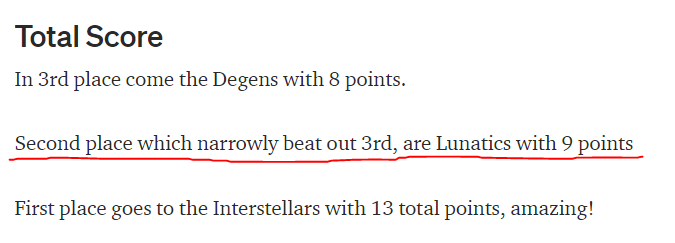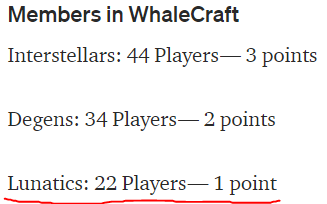
Hi @StarTerra_io!
I did some math around @play_nity allocations and arrived at a different result than yours. 🤨
Could you lend me a hand, please? In absence of clear guidance it is difficult to prepare a tool to estimate future allocation.
🧵👇
/1
I did some math around @play_nity allocations and arrived at a different result than yours. 🤨
Could you lend me a hand, please? In absence of clear guidance it is difficult to prepare a tool to estimate future allocation.
🧵👇
/1
I have joined the IDO as a member of #LUNAtics faction.
Lunatics ranked 2nd. In previous IDOs that meant 30% of gamified pool would go to Lunatics - I assume that's true for $PLY as well, though the article did not mention that explicitly.
/2
Lunatics ranked 2nd. In previous IDOs that meant 30% of gamified pool would go to Lunatics - I assume that's true for $PLY as well, though the article did not mention that explicitly.
/2

That would mean total allocation to Lunatics faction is:
15% (standard) + 15% * 30% (gamified) = 19.5%
With total raise of 420k UST, 19.5% translates to 81.9k UST total allocation.
/3
15% (standard) + 15% * 30% (gamified) = 19.5%
With total raise of 420k UST, 19.5% translates to 81.9k UST total allocation.
/3
AFAIK:
(1) Half of that allocation is guaranteed and split among faction members equally
(2) The other half is lottery-based, with each member getting a lottery ticket for each 250 STE they have (more STE = higher chance of getting a lottery allocation)
Let's focus of (1)
/4
(1) Half of that allocation is guaranteed and split among faction members equally
(2) The other half is lottery-based, with each member getting a lottery ticket for each 250 STE they have (more STE = higher chance of getting a lottery allocation)
Let's focus of (1)
/4
Guaranteed allocation per Lunatics member would be:
81.9k * 50% / NoLFM,
where NoLFM - Number of Lunatics Faction Members.
Now it get's a bit tricky to figure out the actual NoLFM...
/5
81.9k * 50% / NoLFM,
where NoLFM - Number of Lunatics Faction Members.
Now it get's a bit tricky to figure out the actual NoLFM...
/5
Medium article (linked below) mentions 703 total members in Lunatics faction and 22 Lunatics in the WhaleCraft faction.
So either:
NoLFM = 703 (total)
OR:
NoLFM = 703 - 22 = 681 (without whales)
medium.com/@StarTerra/pla…
/6

So either:
NoLFM = 703 (total)
OR:
NoLFM = 703 - 22 = 681 (without whales)
medium.com/@StarTerra/pla…
/6


Problem is:
81.9k * 50% / 703 = 58.25 UST
81.9k * 50% / 681 = 60.13 UST
Each of these is lower than the actual allocation of 63.97 UST.
Don't get me wrong - I am not complaining about getting higher allocation - but I would like to understand where it came from.
/7
81.9k * 50% / 703 = 58.25 UST
81.9k * 50% / 681 = 60.13 UST
Each of these is lower than the actual allocation of 63.97 UST.
Don't get me wrong - I am not complaining about getting higher allocation - but I would like to understand where it came from.
/7

To arrive at ~63.97, we would need to assume NoLFM=640. That's a whole 63 less that the "total" and 41 less than "total - whales".
The only explanation I could come up with (Occam's razor) is: squadrons.
/8
The only explanation I could come up with (Occam's razor) is: squadrons.
/8
Assuming:
(a) "total" accounted for unique wallet addresses (in squadrons and solo)
(b) NoLFM = NumberOfSquadrons + NumberOfSoloFactdionMembers
(c) there were 10 squadrons
(d) only 73 persons signed up for the squadrons
...
/9
(a) "total" accounted for unique wallet addresses (in squadrons and solo)
(b) NoLFM = NumberOfSquadrons + NumberOfSoloFactdionMembers
(c) there were 10 squadrons
(d) only 73 persons signed up for the squadrons
...
/9
...then we would indeed get NoLFM = 640.
Only I can hardly believe only 73 persons would sign up for squadrons when the total squadrons capacity is 100 persons (10 squadrons, 10 members each).
/10
Only I can hardly believe only 73 persons would sign up for squadrons when the total squadrons capacity is 100 persons (10 squadrons, 10 members each).
/10
This is where I run out of ideas. I would like to reverse-engineer these calculations and describe it somewhere - lack of such description is quite frustrating for me (numbers junkie) and possible for other #LUNAtics too.
Halp plz?
/11-end
Halp plz?
/11-end
• • •
Missing some Tweet in this thread? You can try to
force a refresh



